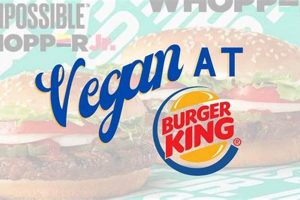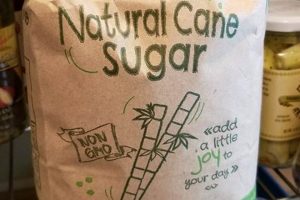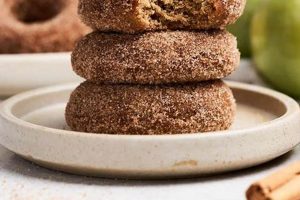A plant-based alternative, often a mixture of ingredients like plant-based milk (soy, almond, or oat) with a touch of sweetener or oil, serves as a replacement for the traditional egg wash in baking. This preparation imparts a similar golden-brown sheen and enhanced texture to baked goods. For example, brushing pastry with a sweetened plant-based milk before baking achieves a desirable browning effect.
The significance of utilizing these substitutes lies in catering to dietary restrictions and ethical considerations, allowing individuals adhering to vegan or egg-free diets to enjoy a wider range of baked products. Furthermore, these alternatives can offer a lighter texture or different flavor profile compared to traditional egg wash, potentially enhancing the final product’s qualities. Historically, the search for such replacements has been driven by growing awareness of dietary needs and a desire for inclusive food options.
The subsequent sections will delve into specific methods and ingredient combinations that effectively replicate the attributes of conventional egg wash, providing a practical guide for achieving optimal results in various baking applications.
Vegan Egg Wash Application
Achieving optimal results with plant-based egg wash alternatives requires attention to detail. These tips aim to maximize the effectiveness of these substitutes in various baking scenarios.
Tip 1: Sugar Content Management: When utilizing plant-based milk with sugar, carefully control the quantity. Excessive sugar may lead to rapid browning or burning, particularly at high oven temperatures.
Tip 2: Oil Application Precision: If employing oil as a replacement, apply it sparingly. An overabundance of oil can result in a greasy texture and affect the overall rise of the baked product.
Tip 3: Protein Enhancement Techniques: For improved browning and crust formation, consider incorporating a small amount of plant-based protein powder into the mixture. This addition can mimic the effect of egg proteins.
Tip 4: Starch Introduction: A light dusting of cornstarch or tapioca starch before applying the liquid can aid in moisture absorption and create a crisper finish.
Tip 5: Temperature Sensitivity Awareness: Plant-based milk alternatives may brown more quickly than traditional egg wash. Lowering the oven temperature slightly or reducing baking time may be necessary.
Tip 6: Multiple Coat Strategy: For a deeper color, apply a second coat of the plant-based mixture halfway through the baking process. Ensure the first layer has partially set before applying the subsequent coat.
Proper application and careful adjustment of baking parameters are crucial for successfully employing vegan egg wash alternatives. These techniques facilitate the creation of visually appealing and palatable baked goods that meet dietary requirements.
The following sections will further explore specific recipes and applications of these alternatives in a variety of baked products.
1. Browning enhancement
Browning enhancement, a critical aspect of culinary aesthetics and flavor development, presents unique challenges when transitioning from traditional egg wash to plant-based alternatives. The Maillard reaction, responsible for the desirable color and flavor compounds in baked goods, is impacted by the absence of egg proteins. Therefore, replicating this browning effect necessitates a strategic approach.
- Sugar Concentration and Caramelization
Higher sugar concentrations in vegan egg wash alternatives directly influence browning through caramelization. Sugars like maple syrup, agave nectar, or even a light dusting of granulated sugar on the surface of the dough caramelize during baking, creating a rich color and a slightly sweeter flavor. However, controlling the quantity is crucial; excessive sugar can lead to burning before the product is fully baked, resulting in undesirable bitterness and texture.
- Plant-Based Milk Composition
The composition of plant-based milk affects the browning process. Varieties with higher fat content, such as oat milk or coconut milk, tend to promote more even browning compared to lower-fat alternatives like almond milk. The fats contribute to heat transfer and surface caramelization. In addition, the presence of reducing sugars in certain plant milks (like some oat milks) can further enhance the Maillard reaction, leading to a more pronounced color development.
- Application Technique and Consistency
The method of application significantly impacts the uniformity of browning. A thin, even coat of vegan egg wash substitute is preferable to a thick or uneven application, which can result in spotty browning or pooling of the liquid. Using a pastry brush with soft bristles ensures a consistent layer. Furthermore, the viscosity of the liquid influences how evenly it spreads across the surface. Thin liquids may require multiple coats, while thicker options require careful distribution.
- Oven Temperature and Baking Time Adjustments
Achieving optimal browning with plant-based alternatives often necessitates adjusting oven temperature and baking time. Plant-based ingredients may brown at a different rate than traditional egg wash. Lowering the oven temperature by a small margin and extending the baking time slightly can prevent burning and ensure that the baked goods are fully cooked. Close monitoring of the browning process is essential for achieving the desired color and texture.
These facets underscore the importance of a nuanced understanding of ingredient properties and baking techniques when striving for optimal browning enhancement with vegan egg wash replacements. Successfully adapting to these alternatives requires careful experimentation and a willingness to adjust established baking parameters to achieve comparable visual and gustatory results.
2. Adhesive properties
Adhesive properties are a crucial attribute of traditional egg wash, influencing the ability to secure toppings, glazes, or decorations to baked goods. When transitioning to egg-free baking, maintaining effective adhesion presents a unique set of challenges requiring careful consideration of alternative ingredients and techniques.
- Starch-Based Solutions
Starches, such as cornstarch or tapioca starch, when mixed with water, create a viscous slurry that can function as an adhesive agent. This mixture, when brushed onto the surface of dough before adding toppings, provides a binding layer. The starch gelatinizes during baking, forming a stable bond between the topping and the baked good. For example, using a cornstarch slurry to adhere seeds to bread or savory pastries demonstrates its effectiveness.
- Sugar Syrup Application
Simple syrup, consisting of equal parts sugar and water, offers adhesive qualities due to its sticky consistency. Applying a thin layer of syrup before adding sprinkles, coarse sugar, or other decorative elements allows these toppings to adhere firmly to the surface. The syrup caramelizes during baking, further enhancing the bond. This technique is particularly effective for sweet baked goods like cookies or pastries.
- Plant-Based Milk and Flour Paste
Combining plant-based milk (e.g., soy, almond, or oat milk) with a small amount of flour creates a paste-like consistency that exhibits adhesive properties. The flour acts as a binder, while the milk provides moisture and contributes to browning. This mixture can be used to secure edges of pastries or to hold fillings in place. For instance, sealing the edges of hand pies with a plant-based milk and flour paste ensures that the filling remains contained during baking.
- Fruit Puree Incorporation
Fruit purees, such as apple or apricot puree, possess natural adhesive qualities due to their pectin content. Pectin, a soluble fiber found in fruits, acts as a gelling agent, providing a sticky surface for toppings to adhere to. Brushing a thin layer of fruit puree onto the dough before adding nuts or dried fruits promotes strong adhesion. This method is suitable for baked goods where the flavor profile of the fruit complements the overall taste.
These alternative approaches demonstrate that adhesive properties can be successfully replicated in vegan baking through the strategic utilization of plant-based ingredients. By understanding the unique characteristics of each ingredient and its potential to create a binding layer, bakers can effectively secure toppings and decorations, achieving visually appealing and structurally sound baked goods without relying on traditional egg wash.
3. Texture modification
The replacement of traditional egg wash with plant-based alternatives directly impacts the texture of baked goods. Egg wash, containing proteins and fats, contributes to both surface crispness and internal softness. Vegan substitutes, lacking these components, necessitate careful adjustments to replicate the textural characteristics. The effectiveness of vegan egg wash is significantly determined by its influence on the final mouthfeel and structure of the product. For instance, a bread dough brushed with a flaxseed gel before baking will exhibit a softer crust compared to one brushed with a simple sugar syrup, demonstrating the direct effect of different substitutes on texture.
Specific ingredients within vegan egg wash alternatives exert distinct effects on texture. Plant-based milks, depending on their fat content, can contribute varying degrees of moisture and tenderness. Starches, when used, create a film that can promote crispness. The method of application also plays a crucial role. A thin, even coating ensures uniform texture modification, while excessive application can lead to a gummy or overly dense result. The practical implications are evident in pastry making, where the desired flakiness can be compromised by improper choice or application of the substitute.
Understanding the interplay between different vegan egg wash components and their effects on texture is crucial for achieving desired outcomes. Challenges arise from the inherent variability of plant-based ingredients, requiring bakers to adapt recipes and techniques based on the specific products used. This highlights the need for experimentation and a refined understanding of ingredient properties to successfully replicate the textural attributes of baked goods traditionally achieved with egg wash.
4. Surface sheen
Surface sheen, a key visual attribute of baked goods, traditionally achieved through the application of egg wash, necessitates careful consideration when employing vegan alternatives. Replicating this glossy finish requires understanding the properties of various plant-based ingredients and their interaction with baking conditions.
- Sugar-Based Glazes and Caramelization
Sugar syrups, such as those derived from maple or agave, contribute a pronounced sheen upon baking. The sugars caramelize under heat, creating a reflective surface. The level of sheen is directly proportional to the sugar concentration and baking time. However, over-caramelization may result in a burnt appearance, diminishing the desired glossy effect. For instance, a light brushing of maple syrup on a vegan challah before baking imparts a notable shine without compromising the bread’s color.
- Oil Emulsions and Dispersion
Plant-based oils, when emulsified with water or plant-based milk, offer a subtle sheen. The oil molecules disperse across the surface, creating a light-reflective layer. The choice of oil influences the final sheen; oils with higher refractive indices, such as olive oil, tend to produce a more pronounced effect. The concentration of oil must be carefully controlled to avoid a greasy texture. An example is the use of olive oil emulsion on focaccia to enhance its visual appeal.
- Plant-Based Milk Proteins and Light Reflection
Certain plant-based milks, particularly soy milk or oat milk, contain proteins that coagulate during baking, forming a thin film on the surface. This film reflects light, contributing to a moderate sheen. The protein content and the level of processing of the milk influence the final effect. Unsweetened soy milk brushed on a vegan pie crust can enhance its golden appearance without introducing excessive sweetness.
- Starch Suspensions and Surface Smoothness
Starch suspensions, achieved by mixing cornstarch or tapioca starch with water, create a smooth surface upon baking. This smoothness enhances light reflection, resulting in a subtle sheen. The concentration of starch must be precisely controlled to prevent a chalky appearance. An example is the use of a thin starch suspension on vegan dinner rolls to create a uniform and visually appealing surface.
These techniques illustrate the diverse methods available to achieve a desirable surface sheen on vegan baked goods. While traditional egg wash provides a straightforward solution, plant-based alternatives offer nuanced control over the final appearance, allowing for adjustments based on the specific recipe and desired outcome. The successful application of these alternatives relies on an understanding of ingredient properties and their response to baking conditions.
5. Flavor neutrality
Flavor neutrality is a significant factor when considering plant-based alternatives to traditional egg wash. The purpose of an egg wash is typically to impart a golden-brown color and a glossy sheen to baked goods without contributing a distinct flavor profile that would alter the intended taste of the recipe. Therefore, any vegan substitute must ideally possess similar flavor neutrality to avoid undesirable alterations to the final product’s taste.
The selection of a plant-based alternative directly impacts the flavor of the baked item. For example, brushing pastry with sweetened almond milk imparts a subtle almond flavor, which may complement certain recipes but clash with others. Similarly, using olive oil as a wash, while effective for browning, introduces a noticeable olive oil flavor that is not suitable for sweet baked goods. Consequently, ingredients like unsweetened soy milk or a diluted starch slurry are often preferred for their minimal flavor impact, allowing the inherent flavors of the baked product to remain dominant. The ability to maintain flavor neutrality is a key determinant of a successful vegan egg wash substitute.
Ultimately, the suitability of a plant-based egg wash hinges on its ability to provide the desired visual and textural attributes without compromising the intended flavor of the baked product. This requires careful consideration of ingredient properties and their potential flavor contributions. Achieving flavor neutrality, therefore, represents a critical component in the successful application of vegan egg wash alternatives, ensuring the preservation of the original flavor profile while meeting dietary requirements.
6. Crust formation
The formation of a desirable crust on baked goods is a critical aspect of their appeal, influencing both texture and flavor. When traditional egg wash is replaced with vegan alternatives, specific adjustments are required to achieve comparable results in crust development. The composition of the chosen substitute significantly affects the crust’s characteristics.
- Sugar Content and Caramelization
The sugar content within the vegan egg wash directly affects crust formation through caramelization. Sugars, such as maple syrup or agave nectar, caramelize under heat, creating a browned and often crisp crust. The rate of caramelization depends on the type and concentration of sugar used. However, excessive sugar can lead to premature browning or burning, impacting the overall texture. For example, a pastry brushed with a high-sugar syrup may develop a dark, brittle crust that is not desirable.
- Fat Content and Crust Texture
The presence of fats in the vegan egg wash influences crust texture. Plant-based milks with higher fat content, such as oat milk or coconut milk, contribute to a more tender and less brittle crust. The fat molecules interfere with gluten development on the surface, resulting in a softer texture. Conversely, lower-fat alternatives may result in a tougher crust. This is evident when comparing a bread crust made with oat milk versus one made with almond milk; the former typically exhibits a more delicate texture.
- Starch Application and Crust Crispness
The application of starches, such as cornstarch or tapioca starch, can promote a crisp crust. A thin layer of starch mixed with water creates a coating that dehydrates during baking, resulting in a brittle and crisp surface. The effectiveness of starch application depends on the concentration and uniformity of the coating. Overly thick applications can lead to a gummy texture. For example, a pie crust brushed with a thin starch slurry before baking will exhibit a more pronounced crispness.
- Protein Content and Maillard Reaction
The Maillard reaction, responsible for browning and flavor development, is influenced by the presence of proteins. While vegan egg wash alternatives typically lack egg proteins, some plant-based milks contain proteins that can contribute to this reaction. Soy milk, for example, contains proteins that can interact with reducing sugars in the dough, promoting browning and flavor development. However, the effect is generally less pronounced than with traditional egg wash, necessitating adjustments to baking time and temperature to achieve similar results.
These components underscore the importance of selecting the appropriate vegan egg wash alternative based on the desired crust characteristics. By understanding the influence of sugar, fat, starch, and protein content, bakers can effectively manipulate crust formation to achieve results comparable to those obtained with traditional egg wash, catering to both dietary restrictions and textural preferences.
Frequently Asked Questions
The following section addresses common inquiries regarding the utilization of plant-based substitutes for traditional egg wash in baking. These responses aim to provide clarity and guidance for achieving optimal results.
Question 1: What is the primary function of traditional egg wash that needs to be replicated by vegan alternatives?
The primary functions of traditional egg wash include imparting a golden-brown color, adding a glossy sheen, and assisting in the adhesion of toppings or decorative elements to baked goods. Plant-based substitutes strive to replicate these properties.
Question 2: What are the most effective plant-based ingredients for creating a vegan egg wash, and why?
Effective plant-based ingredients include plant-based milks (soy, oat, almond), sugar syrups (maple, agave), and oil emulsions. Plant-based milks contribute moisture and browning, syrups enhance color and adhesion, and oil emulsions add sheen.
Question 3: How does the sugar content in a vegan egg wash alternative affect the browning process, and what precautions should be taken?
Higher sugar content promotes faster browning through caramelization. Precautions include monitoring baking time and temperature to prevent burning and adjusting sugar concentrations to achieve the desired color without compromising texture.
Question 4: Can vegan egg wash alternatives effectively secure toppings to baked goods, and what techniques enhance adhesion?
Yes, vegan egg wash alternatives can effectively secure toppings. Techniques such as using starch slurries, sugar syrups, or plant-based milk and flour pastes enhance adhesion.
Question 5: Does the application of a vegan egg wash alter the texture of baked goods, and if so, how can it be managed?
Yes, the application can alter texture. Adjustments to ingredients, such as using plant-based milks with higher fat content or incorporating starch, help manage the texture and achieve desired results. Thin and even application is also critical.
Question 6: Are there any flavor considerations when choosing a vegan egg wash, and how can flavor neutrality be ensured?
Yes, flavor considerations are important. Choosing neutral-flavored ingredients like unsweetened soy milk or diluted starch slurries ensures that the inherent flavors of the baked product remain dominant.
In summary, successful implementation of vegan egg wash alternatives requires careful consideration of ingredient properties and their impact on browning, adhesion, texture, and flavor. Experimentation and adaptation are essential for achieving optimal outcomes.
The following section will provide detailed recipes for the most effective vegan egg wash alternatives, incorporating the principles discussed above.
Egg Wash Vegan
This exploration of “egg wash vegan” has illuminated the viable plant-based alternatives available to bakers seeking to replicate the functionality of traditional egg wash. Key points include the importance of understanding ingredient properties, controlling sugar and fat content, and adjusting baking parameters for optimal browning, adhesion, texture, and flavor neutrality. The successful implementation of these substitutes enables the production of visually appealing and palatable baked goods that meet dietary requirements.
The ongoing development and refinement of these techniques hold significant potential for expanding the accessibility and inclusivity of baked goods. Continued experimentation and knowledge sharing will further advance the art of plant-based baking, ensuring that ethical and dietary considerations need not compromise the quality or appeal of baked creations. The future of baking relies on embracing innovation while upholding established standards of culinary excellence.







